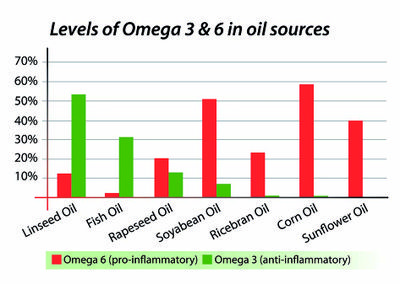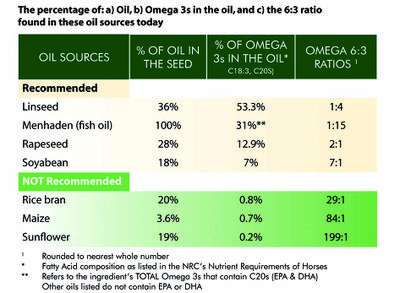Not All Oils Are Equal

What are the main sources of "essential" fatty acids and what are the effects of adding them to the horse's diet?
Several studies have been presented since 1986 showing improved stamina and endurance in performance horses as a result of including fats and oils as an energy source in their diets. From a calorie stand-point, all vegetable oils are created equal as they provide approximately 2 ¼ times as many as the equivalent amount of cereal grain. However, different oils contain different amounts of “essential fatty acids” so are not equal from a nutritional point of view and the most recent research focus has been on the feeding of different specific oils. When oil is digested, free fatty acids are incorporated into cell membranes but some fatty acids cannot be synthesized by the horse, or not in sufficient quantities to meet their nutritional needs, so are called “essential” fatty acids and must be available in the diet on a daily basis. Two of these essential fatty acids are called Omega 6 and Omega 3.
Oil Content
Horses evolved as continuous grazers of forage, consuming large quantities of fresh grass every day. Results of a two-year study conducted by Dr Lori K Warren, Assistant Professor of Equine Nutrition at the University of Florida, stated, “The oil content of fresh grass will depend on its maturity, varying between 3% and 5% and comprising 40% to 55% Omega 3 fatty acids.” Today, horse owners have replaced much of the fresh pasture diet with dry hay and, Dr Warren points out, “The oil content of hay will also depend on its maturity and will vary between 1% and 3% comprising 18% to 35% Omega 3s.” Cereal grains, on the other hand, contain around 3% or 4% oil of which 50% is Omega 6 with very little Omega 3.
Keeping a Balance
"There has been considerable work in other animal species, as well as humans, to show that Omega 3 supplementation affects the ratio of Omega 6:3 in blood and in tissues, with alterations in the fatty acid composition of plasma (cell) membranes," says Dr Ray Geor BVSc MVSc, professor at Virginia Polytechnic and State University. Oils containing higher levels of Omega 3 are found in the natural diet of horses (forage) and can be digested easily with positive affects in the horse’s system but the Omega 6:3 ratio must be kept in balance when additional oils are included in their diet.
Cereal grains, like oats, barley, maize, wheat, rice, etc, as well as the oils from sunflower, maize, rice bran and cottonseed, all contain high percentages of Omega 6 in relationship to their Omega 3 levels. All Omega 6 fatty acids are pro-inflammatory which helps maintain the animal’s immune system and is beneficial during infection and sickness. However, if too many Omega 6 fatty acids are fed, an imbalance can occur, leading to an altered physiological state and potentially harmful inflammation. On the other hand, Omega 3 fatty acids are potent, anti-inflammatory agents that help reduce pain and swelling and help return the horse’s system to normal function. So, as with all nutrients, balance is the key.
Which Oil Sources are Best
The table on the left shows the percentage and ratios of Omega 6 and Omega 3s contained in the different oil seeds and fish oil available today. The right table shows which oils are best for the horse, in descending order of their total Omega 3 content, from top to bottom. The top four oil sources are the best for increasing the Omega 3s in the diet and the bottom three sources are the ones which are not recommended for adding to your horse’s diet because they could provide too many Omega 6s without adequate Omega 3s. Feeding a specially formulated high oil supplement, like Baileys Outshine, however, reduces the risk of an Omega 6:3 imbalance by supplying a blend of linseed and soya oils plus the necessary supporting antioxidants.


Great Benefits
Supplementing the equine diet with oils that contain higher levels of Omega 3 has proven to be beneficial to all horses that are not eating fresh grass pasture for at least 18 hours per day. Short-term benefits include improved skin and coat condition, fewer skin allergies and anti-inflammation characteristics. Long-term benefits are numerous and are thought to include improved hoof quality, increased bone density, improved joint health and reduced muscle soreness, as well as increased tissue elasticity which reduces the incidence of EIPH (nasal bleeding) in performance horses. In addition, mares’ milk contains higher Omega 3 levels which can result in healthier foals, by supporting their immune system resistance to infection, whilst Omega 3s also support stallion fertility by helping maintain sperm cell viability.
Adapting to Oil
As with any change in diet, a significant increase in the overall oil content of a horse’s diet must be made gradually to allow the digestive system to adapt. Bile is the substance which aids oil digestion and is produced by the liver and stored, in humans, by the gall bladder. Being a trickle feeder, the horse does not have a gall bladder to store bile as it does not naturally have to digest high fat meals. Rather the liver produces a constant gentle flow of bile and, given time, can adapt remarkably well by increasing this steady bile production.
200 – 500ml of vegetable oil are required to make a significant additional calorie contribution and can present palatability problems making specially formulated high oil supplements an appealing alternative. The body’s requirement for antioxidants is also increased, the higher the oil content of the diet, as free radicals are produced during its metabolism and these can be supplied by the addition of a vitamin E and selenium supplement.


